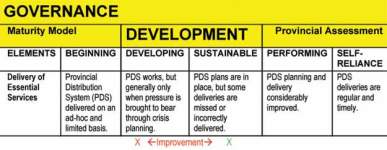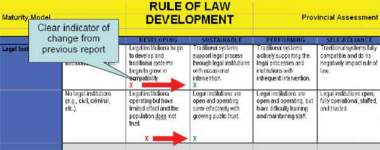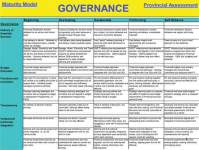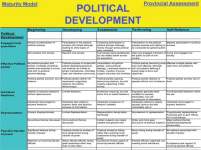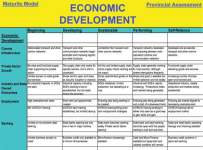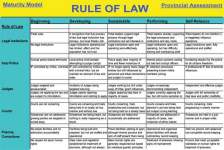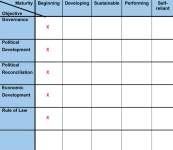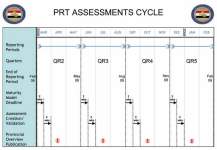
Assessments and Measures of Effectiveness in Stability Operations Handbook
Handbook 10-41
May 2010
Appendix B - Provincial Reconstruction Team Maturity Model
Lines of Activity
Each provincial reconstruction team (PRT) assesses its province in five areas or lines of activity (LOAs). The LOAs include the following: governance, political development, economic development, political reconciliation, and rule of law. The five LOAs and key objectives are derived from the joint campaign plan and mission plan that the PRTs/embedded PRTs are tasked to assess:
- Governance. Assist in the development of sub-national governments that are self-sufficient, transparent, accountable, and capable of identifying, prioritizing, and servicing the needs of their citizens.
- Political development. Promote the development of an engaged local population and effective political parties, institutions, representatives, and officials that respect rights of individuals and groups, promote pluralism, and peacefully transfer power.
- Reconciliation. Assist conflicting parties resolve their differences by engaging in direct and peaceful dialogue to identify and pursue shared aims and interests.
- Economic. Help sub-national governments and the private sector to establish and implement broad-based and comprehensive economic development strategies that promote equitable and sustainable growth.
- Rule of law. Enhance the quality of justice enjoyed by the populace by improving the accountability, effectiveness, and consistency of services administered by policing, corrections, judicial and other legal institutions.
- Security is the responsibility of the relevant military units operational within the each province.
Maturity Model Assessment
This section describes how to use the maturity model to make an assessment of the provincial council or other institution together with worked examples and blank templates that can be copied and used.
The model
The maturity model is an internationally recognized tool for assessing the progress of major change management programs. The assessment will be completed by reading generic statements (provided as appendices to this handbook) and making an objective assessment of where the local government organization best fits the descriptions.
For example, when considering the development of governance it is decided the statement "Provincial Distribution System delivered on an ad-hoc and limited basis" best fits the description of the delivery of services. If so, place an X in the box marked "Beginning." Continue making assessments throughout all of the key objectives.
Referring to Figure B-2, if the best description that fits the legal institution is, "Traditional systems support legal process through legal institutions with occasional intervention" then place an X in the "Sustainable" box as shown. Importantly, provide some concise statement of evidence to support the assessment-in this case supporting the improvement in performance from "Developing" to "Sustainable." Note that the red X is the previous rating and the green X is the current one. This can be added on a separate sheet attached to the maturity model.
In Figure B-2, three of four areas have shown improvement (three of the areas are the completed assessments for the component elements of the maturity model can be used as a basis to adjust the PRT's work plans).
After a PRT assesses its provinces for all five LOAs, it summarizes the results in an overview chart called the behavior statement (see Figure B-8).
Assessments for both the maturity model and the behavior statement fall within five capacity levels: beginning, developing, sustainable, performing, and self-reliant.
The assessments provide brief comments about each objective that describe how the province is performing and highlighting any resource issues that would enable the objective to be moved towards self-reliance or major blockers to achieving an upward trend.
(Note: Depending on information requirements and other factors, the PRT may have a different assessment reporting cycle from the reporting cycle of the military unit in the operational area.)
|
NEWSLETTER
|
| Join the GlobalSecurity.org mailing list |
|
|
|



